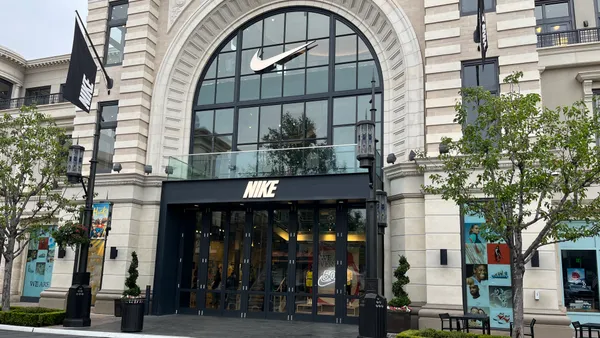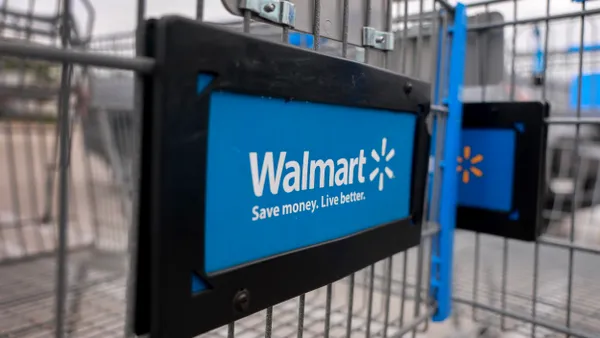It’s nearly the most wonderful time of the year again — especially if you work in retail. Brick-and-mortar stores and e-commerce sites alike will get plenty of attention during the biggest buying period of the year, but the season isn’t without its pitfalls.
Retailers can rise or fall significantly based on their holiday performance — and knowing what customers are expecting, hoping for and trying to avoid at all costs can help put retailers on the right path for a successful season.
Enter, the National Retail Federation’s 2017 Retail Holiday Planning Playbook, filled with data on consumer behavior and key trends to watch as the critical period rapidly approaches.
We’ve combed through to find the top four things consumers want this holiday season.
-
More online wishlists
While holiday shopping might conjure up images of children scrawling handwritten letters to Santa Claus, NRF’s survey indicates that notes and wish lists might be transitioning to the digital stage. With online shopping playing an increasingly important role in just about every holiday, more consumers are looking to build their wish lists online rather than on paper.
According to the NRF, 63% of shoppers would like to use online wish lists to help organize their gift purchases, although only a quarter of respondents currently use online wish lists. That being said, 47% of respondents said they will look in physical stores to find the perfect gift and 44% will go straight to family and friends for gift ideas or hints.
Whether consumers are shopping in stores or online, it’s clear that being able to create an online wish list is highly desirable for consumers. Retailers should also take into consideration the purchasing habits of omnishoppers, 75% of whom make purchases online after shopping for something in-store. The ability to create a wish list could cater to these types of shoppers, not only if they’re looking for family and friends, but also if they want to record their own wish list to send out to family members.
"For consumers looking to create efficiency in the shopping process, adding an easy resource reduces friction and increases the likelihood of a conversion," according to the study. "Retailers that already have wedding or baby registries should consider how easily they can convert or add registries for other occasions, allowing consumers to regularly add, remove and share their lists."
The study recommends retailers stress convenience in the list-making process, so it’s easy for consumers to create wish lists on their websites and share them. For younger consumers, they even recommend having influencers make their own wish lists to share with followers. After all, what’s the point of a holiday list if you can’t let everyone know what you want, how much you want and in what color?
All the same, Marshal Cohen, chief industry analyst at the NPD Group, said there’s only "marginal acceptance" of online wish lists among the younger generations.
"It’s an added benefit, but it’s such a small, young piece of the puzzle," Cohen told Retail Dive. "Absolutely it’s going to represent a growth opportunity, but that doesn’t mean it’s going to take the market by storm."
-
Transparent return policies and reviews
Transparency is key for retailers heading into the holiday shopping season. Not only do customers want transparent and generous return policies, but many of them will be taking into consideration customer reviews (whether good or bad) before they buy a product.
The NRF found that three fourths of the holiday shoppers surveyed checked return policies before making a purchase, while 22% backed out of a purchase because of a bad return policy. While that number may not seem high on first glance, it could have serious impacts for retailers that don’t stack up when it comes to returns. After all, that’s almost one in every four shoppers who are willing to dump a product if the return policy isn’t as generous or as transparent as they’re looking for.
Retailers might also consider that returns are more likely from those who shop online. A recent study by Corra found that while 75% of consumers rarely or never return items bought in-store, that number drops to 61% when the item was purchased online. That percentage is highest among millennials.
To that end, having a transparent and generous return policy is a smart move for retailers looking to drive traffic over the holidays; otherwise, they could face losing key consumers who aren’t willing to take a risk on their products. Shoppers listed the following reasons for deciding against a purchase: lack of free return shipping (57%), only store credit offered instead of a full refund (55%), an inability to return items in-store (43%), too small of a return window (42%) and too difficult to return in-store (39%).
Bad return policies can make holiday shoppers decide against certain purchasesBeing transparent about product reviews is another make-or-break moment of the customer journey, according to the NRF. For retailers that heed customer reviews and respond accordingly — whether to apologize for a bad experience or make changes based on customer feedback — reviews can encourage shoppers to make a purchase they otherwise weren’t sure about. However, for retailers that ignore customer reviews, consumers are likely to shop elsewhere, which is dangerous for an industry that’s struggling as it is.
"Retailers are not knocking the socks off of anybody’s business model," Cohen said, predicting a 2.5% to 3% sales growth over last year's holiday period. "There are very few retailers who are ahead of the game, so when we look at who’s running so far ahead that they can afford a lackluster holiday season — it’s nobody."
Paying attention to customer reviews may be able to help. Almost every shopper surveyed by the NRF (96%) said they read reviews on a retailer’s site before making purchases and 25% of those said reviews provided the most help when making holiday purchase decisions last year. A large majority (63%) also write product reviews — the highest percentages falling to Gen Z (81%) and millennials (75%) — and almost three quarters (73%) are more likely to do so when they’re pleased with their experience.
That doesn’t mean unhappy customers are staying silent. In fact, the stakes are higher with customers who aren’t satisfied — of those who write product reviews, 57% are expecting the retailer to reply and 93% of those said their brand loyalty would be negatively impacted if they didn’t receive a response. That doesn’t mean that product reviews are a death sentence for retailers. Quite the contrary — retailers who pay attention to the reviews they receive and make amends for their mistakes score major points with consumers.
The NRF cites Walmart as a key example. After receiving negative feedback about holiday checkout processes, the big box retailer changed their process for 2016 and instituted ‘Holiday Helpers’ to speed up checkout lines. "These associates directed shoppers to the next available cashier, opened an extra register if needed, helped with price checks and grabbed items a shopper may have forgotten," the study states, demonstrating just one example of a retailer who learned from previous reviews and used the information to its advantage.
-
Personalized recommendations and purchase guides
While many shoppers like scoping out the perfect gift for themselves, or looking to family members for ideas, over half of the survey’s respondents (54%) used a retailer’s recommendations when making their lists last year and that same percentage started researching for their holiday gifts in October.
The big takeaway from these stats is that holiday shoppers want detailed product information and personalized customer service. The more expensive a product is, the more research customers want to conduct before committing to it. That said, the numbers are high across the board: 66% of shoppers do research for items that are less than $50, while 85% research for products between $50-$100 and 89% conduct research for items $100-$150, $150-$200 and anything over $200.
As a result, retailers should "be research-ready by October" and work to encourage and assist customers with their holiday research, according to the NRF. One way of doing that is by having product details and information easily available online and on mobile apps, as well as by sending out content or buying guides.
"Some retailers are now incorporating QR codes on their products and displays so that in-store consumers can easily access the product’s web page on their phone," the study states, mentioning Best Buy’s drone buying guide last season as a good example of encouraging research.
Holiday shoppers conduct research for even relatively low price rangesWhile moves like this can help shoppers feel more secure about the gifts they’re buying for others, they could also convince shoppers to splurge on an impulse purchase for themselves. Despite the majority of shoppers making the same or fewer impulse purchases than they did last year (48% made more), the study states that "triggering that emotional, on-the-spot purchase can still be an important tool for retailers to drive holiday spend."
How do retailers manage that? By sending out limited time promotional offers, as well as placing complementary products next to each other in stores, according to the NRF.
While sending out coupons and discount notifications might seem old-school for the digital age, 72% of coupons used in 2016 affected purchasing behavior — usually by encourage shoppers to buy a product they otherwise would not have. According to that study, conducted by Inmar, 65% of shoppers said they would try a new product if they had a coupon for it and 58% would abandon their regular brand for a different one if the other brand offered a coupon.
If a well-targeted coupon is all it takes to get most customers to try out a new product, then those are great stats for retailers looking to draw in new customers during the holiday season. Additionally, younger consumers are even more likely to make impulse purchases than older ones; the NRF found that 66% of millennials and 71% of Gen Z said they made more impulsive purchases this year than the year before, which is good news for retailers catering to young consumers.
Even so, some retailers may not be able to stay above the fray.
"The bigger you are, the more vulnerable you tend to be," Cohen said. "It’s hard to maintain that kind of volume all the time. I think select stores within channels of distribution will do well. Someone like a Target or a Walmart will do well, the off-pricers will do well, but not everyone in one channel is going to do well."
-
Convenience
Convenience, as ever, is the name of the game for retailers — especially during the holidays.
Shoppers (many of whom are parents) are usually juggling their holiday shopping with their job, kids, housework and a social life. Making it easy for holiday shoppers to get their shopping done whenever they have time for it — whether that’s weeknights or weekends — can give retailers a huge boost during the season.
Almost all (90%) of the NRF’s respondents admitted that some aspect of their experience convinced them to make purchases that they were otherwise hesitant about, with the majority (64%) citing free shipping as the catalyst for their purchase, while half cited limited-time sales or promotions and 33% named buy online, pickup in store capabilities.
While many retailers already tout high level of convenience — think Walmart’s "Express Money Services" feature, pickup towers and newly-released "Easy Reorder" — those who go the extra mile for their customers’ convenience during the holiday season could really reap the benefits.
According to the NRF, online retailer eBags updated its mobile app last year so that customers could find what they were looking for in less than four seconds and as a result, its mobile traffic grew by 92% between Thanksgiving and Cyber Monday.
Some factors, like free shipping, convinced hesitant holiday shoppers to go through with a purchaseCustomers who feel that they are being inconvenienced in some way, however, take it seriously, with 64% of customers who had trouble making a return saying they would be wary of shopping at that retailer ever again. And with nearly a third (32%) of customers price checking products on Amazon while in store, and 23% on Google, retailers risk losing customers to competitors who are offering better products and services.
"[This holiday season] is really about stealing share," Cohen said. "It’s not about getting more customer dollars — customers don’t have more dollars. If there’s going to be any growth, it’s going to come at the expense of somebody else."
This story is part of our ongoing coverage of the 2017 holiday shopping season. You can browse our holiday page and sign up for our holiday newsletter for more stories.
















